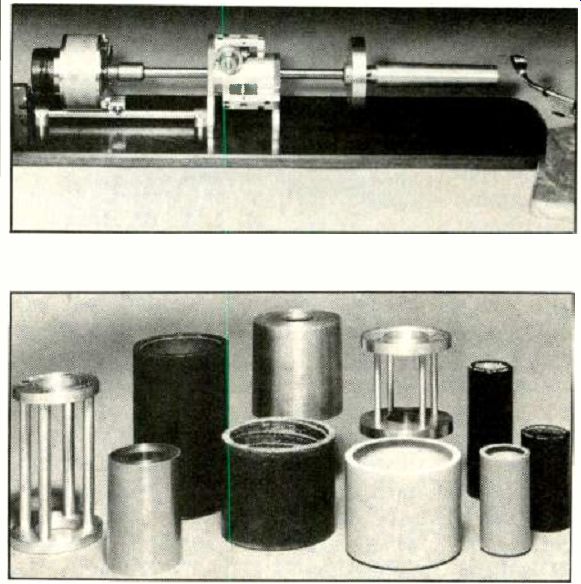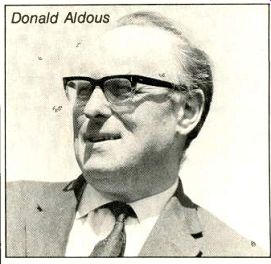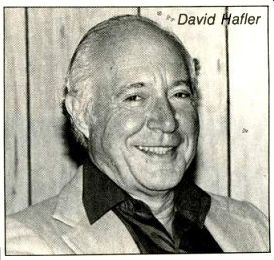Pengelly Cylinder Player
Editor's Note:
This item, which makes for an interesting postscript to our May 1984 feature, "Old-Tyme High-Tech Electronic Cylinder System," was recently sent to us by Donald Aldous. A consulting editor for Britain's Hi-Fi News, Aldous was recently honored for his achievements in audio (see following announcement).
In 1977, the Royal Scottish Museum in Edinburgh staged a major exhibition and symposium to celebrate the centenary of the invention of re corded sound and playback by Thom as Alva Edison. Among the contributors to the symposium from the U.S. and Europe was Joe Pengelly, an Englishman renowned as a specialist in the electrical reproduction of the earliest mode of sound recording on cylinder. Pengelly, an Oxford University graduate and an Hon. Research Fellow in Oral History at Exeter University, was a BBC man for some 20 years. In 1977, he compiled and presented the BBC's Centenary program on the invention of recorded sound. Examples of his archive work can be found in the Library of Congress, the White House Special Collection, the Royal Archives at Windsor, and the BBC Archive section.
As the result of the sound quality he was able to reproduce from cylinders made at the turn of the century, Pengelly was invited to the Edison National Historic site at West Orange, N.J., to transcribe certain important cylinders in the Edison archive.
Until recently, Pengelly worked with original (but modified), spring-driven Edison cylinder machines. In 1983, however, he was awarded a Lever hulme Research Grant to construct a completely new, electrical, cylinder-re play mechanism. This design was built by the Department of Mechanical Engineering at Plymouth Polytechnic in En gland's Westcountry. The actual work was carried out under the supervision of Engineer-in-Charge Terry Bouncer; Mike Springer was responsible for the actual construction.
The basic mandrel on the machine can accommodate the more common-size cylinders, while a number of additional slip-on mandrels can provide re play for every type and size of cylinder, with the exception of the two smallest "cotton reel" cylinders produced by the French Lioret company.
The basic difference between this and other electrical replay mechanisms produced so far is that in the Pengelly system the reproducer re mains still and the mandrel travels laterally beneath a stationary pickup-in this version, an SME arm and suitable cartridge/stylus. Any freestanding pickup arm can, however, be used.
The principle of a laterally moving mandrel was employed by Edison as far back as his first experimental tinfoil cylinder machine in 1877, and again on his most sophisticated machines some 30 years later. The servo-con trolled motor drive can accommodate variable speeds between 40 and 200 rpm.
-Donald Aldous

(top) The cylinder player invented by Joe Pengelly in 1983 features a mandrel that travels laterally beneath a stationary pickup. (above) Pengelly's modern player can accommodate a wide variety of cylinder sizes, including all of these, and more.
Hi-Fi News Awards
Net long ago. England's Hi-Fi News & Record Review reinstated a long standing tradition-its annual presentation of awards to those who have made significant contributions to re corded music. However, the awards (which had been suspended for 2 1/2 years) have returned with a new twist:
Unlike the old Audio Awards, which originally honored individual recordings, the new Hi-Fi News Awards celebrate the general achievements of high-fidelity engineers and journalists.
Also unlike the earlier award, recipients of the new honor will not be restricted to Britons, but will include audio professionals from around the world.
Accordingly, the 1985 awards have gone to three Americans-David Hafler, J. Gordon Holt, and Edgar Villchur-as well as three of England's native sons-Donald Aldous, Stanley Kelly, and Peter Walker.
A technical journalist for many decades, Donald Aldous published his first piece in Popular Radio, in 1933. In the same year, he was a founder-member of the British Sound Recording Association, forerunner of the AES. In 1935 he began writing for Gramophone Record Review, later serving as technical editor after GRR became Audio Record Review. Between 1945 and 1955, Aldous was director of Walden Films, where he was particularly involved with audio-visual aids and direct to disc recording. During this time, he continued writing for a variety of journals; he also published technical manuals and helped produce a usable magnetic recorder before any commercial machines of the type were available. Today, Aldous is consulting editor of Hi-Fi News, program organizer of Plymouth Film Theatre, and vice president of the Torbay Gramophone Society. He recently published Sound Systems, a book for audio beginners.
An engineer who learned while on he job during his World War II military service, David Hafler is best known for the design and manufacture of amplifiers offering high-end performance at affordable prices. This he began doing through Dynaco, the manufacturing company he founded in 1956, after obtaining a patent for an ultralinear circuit design. Notable among Dynaco's early offerings was a 50-watt amplifier, considered by many at the time to be far more powerful than necessary. Planning to retire, Hafler sold Dynaco in the late '60s. But by the mid-'70s he was back in business with the David Hafler Co., producing a new generation of high-performance amplifiers.
The founder, editor and chief tester for The Stereophile, J. Gordon Holt began his journalistic career at High Fidelity, where he was technical editor from 1955 to 1960. He left to publish a newsletter for Weathers, a manufacturer of cartridges and turntables; it was this newsletter that eventually became The Stereophile. Though Holt has writ ten for other magazines, his name re mains most closely associated with The Stereophile, which is considered by many to be a seminal "under ground" audio publication and a mod el for others of its kind.
An electronics designer for five decades, Stanley Kelly spent the years before World War II as an engineer for Standard Telephones & Cables and for Philco. After the war he was chief engineer at Cosmocord, where he helped design microphones and pickups, including the first commercial pickup using a cantilever stylus. In 1954 Kelly left Cosmocord to start his own firm, Kelly Acoustics, which manufactured tape-recorder microphones, specialized test equipment, sapphire styli, and one of his best-known products, the Ribbon Loudspeaker. In 1964, Kelly sold the Ribbon's manufacturing rights to Decca, for whom he continued designing audio products; he has also designed speakers, transducers and filters for the OEM market. Today he is a technical adviser to Hi-Fi News.
Edgar Villchur cofounded Acoustic Research and served as its president and director from 1954 to 1967. Among his introductions during this time were the acoustic-suspension speaker and the dome tweeter. But it was the AR turntable, launched in 1961, that is considered Villchur's most noteworthy achievement. A simple, belt-drive design, it pioneered the use of a three-point suspended subchassis and is regarded by many as the fore runner of almost all high-end turntables on the market today. Villchur is currently president and director of research for the Foundation for Hearing Aid Re search; he is also affiliated with the Massachusetts Institute of Technology and the Albert Einstein College of Medicine.

----------- Donald Aldous

------------David Hafler
Though he is best known for his loudspeakers, Peter Walker's firm, the Acoustic Manufacturing Company, was in business for 14 years before its first commercial loudspeaker design, the Corner Ribbon, debuted in 1950. The following year the company was renamed Quad, after its first domestic amplifier: The Quality Unit Amplifier, Domestic. In the ensuing years Quad pioneered the design of amps, preamps, tuners and loudspeakers, including the now legendary Quad ESL, introduced in 1956 and still in production, and its successor, the ESL-63, which was in development for 18 years before its introduction in 1981.
(Audio magazine, May 1985)
Also see:
Old-Tyme High-Tech Electronic Cylinder System
From the people who brought you Franz Liszt? (Apr. 1972)
= = = =